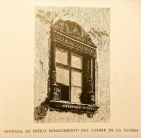
Architectural details in Palma
"It’s curious how our sight only focuses on details, like a couple of windows, a door, a patio, a staircase; we don’t see a home that is architecturally rich as a whole or consider it artistically as a single finished whole. Perhaps the only exceptions are the Town Hall, the Marquis of Palmer’s home on Carrer del Sol street and some very noteworthy modern buildings.
There is hardly any trace of Arab architecture left in Palma. It’s noteworthy that such an important Moorish city would have been completely transformed by its Christian conquerors. All that remains from that period are some baths, some fortified towers and the palace’s main entry arch. The main buildings that can still be seen today are all from the medieval period or the Renaissance. Amongst the former is the Llonja market, shining like a splendid jewel. Also worth noting are windows in some private homes with two, three and even four arches supported on very delicate columns which resemble flower stalks and tend to be made of very hard nummulithic limestone. The capitals on these columns are very different: tetragonal with vegetation as decoration, primarily leaves, though also quite frequently with rosettes on the sides.
 The most common window consists of three arches mounted on a flat surface though it’s sometimes animated with a series of rosettes. Unfortunately, these windows which decorate facades so harmoniously and referred to as “coronelles” have been replaced over time by balconies which stick out. Contrarily, their thin columns have been lost. They are increasingly harder to find in their primitive state as only a few houses still have them.
The most common window consists of three arches mounted on a flat surface though it’s sometimes animated with a series of rosettes. Unfortunately, these windows which decorate facades so harmoniously and referred to as “coronelles” have been replaced over time by balconies which stick out. Contrarily, their thin columns have been lost. They are increasingly harder to find in their primitive state as only a few houses still have them.
 The flourish during the Renaissance produced much richer artistic treasures than the Gothic period. From the former are some of the city’s most beautiful architectural details, particularly the windows, at times even representing a bounty of richness. But where this style is present in all its full value is in the entryways. From the Baroque period are a few remains limited to the ornamentation of some nobles’ coat of arms and some entryways which, all in all, preserve their Renaissance character. We cannot say that in Spain, as compared to other countries, one style has been substituted by another. Rather, the different particular styles have been able to coexist, at times intermingling in a surprising way. It is very characteristic that in Spain, during the 17th and 18th centuries, buildings were still being made in the Gothic style, while, in other countries during that same time, the pointed arch was completely eliminated."
The flourish during the Renaissance produced much richer artistic treasures than the Gothic period. From the former are some of the city’s most beautiful architectural details, particularly the windows, at times even representing a bounty of richness. But where this style is present in all its full value is in the entryways. From the Baroque period are a few remains limited to the ornamentation of some nobles’ coat of arms and some entryways which, all in all, preserve their Renaissance character. We cannot say that in Spain, as compared to other countries, one style has been substituted by another. Rather, the different particular styles have been able to coexist, at times intermingling in a surprising way. It is very characteristic that in Spain, during the 17th and 18th centuries, buildings were still being made in the Gothic style, while, in other countries during that same time, the pointed arch was completely eliminated."
Archduke Ludwig Salvator of Austria. Las Baleares por la palabra y el grabado. Majorca: City of Palma. Ed. Sa Nostra, Caja de Baleares. Palma de Mallorca. 1982.



















